Restoring Degraded Forests with Rosewood
July 15, 2020
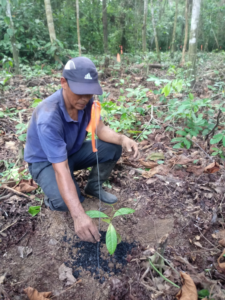
Rosewood (Aniba rosaeodora) is a unique type of tropical hardwood, noted for the dark red color that stains its inner trunk and a sweet smell that gets processed into Rosewood essential oil, which is a major ingredient of high quality perfumes and cosmetic products. The oil is obtained from tree trunks through steam distillation from chipped wood and bark, methods that require the destruction of the tree. Because of this economic value, rosewood trees have been cut in such large proportions in the Amazon that natural populations are significantly depleted. It is internationally recognized by the IUCN Red List as an endangered plant species. Thus, with support from the National Fish and Wildlife Foundation, Amazon Conservation began a project to recover a population of rosewood and explore the use of this species for reforestation and restoration of degraded forests damaged by slash-and-burn agriculture and artisanal, illegal gold mining.
The lowland Amazonian forests at our Los Amigos Conservation Hub in Peru offer the perfect conditions for re-establishing rosewood trees. The areas at Los Amigos selected for planting had previously been disturbed by slash-and-burn agriculture and artisanal gold mining, but surrounded by primary forest. The project demonstrates that rosewood is a species that can be used in projects to restore degraded lands, which can be applied to thousands of hectares of degraded lands across the region impacted by extractive activities. Moreover, the trees planted in this project can serve as a seed bank for others who may wish to reforest and conduct ecological restoration that includes rosewood, either for strict conservation or for managed, nondestructive leaf harvest, which could generate additional income for local communities.
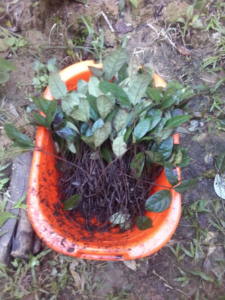 Getting Started: A Quest to Find Rosewood Seedlings
Getting Started: A Quest to Find Rosewood Seedlings
We planned to purchase rosewood seedlings from a local provider in the region of Madre de Dios, Peru, but this proved to be a challenge due to the scarcity of rosewood seeds. After contacting a number of providers throughout Peru, we obtained 2,500 seedlings from our friends at the nonprofit Camino Verde, located in northern Peru.
The long trip from northern Peru took its toll on the seedlings. Upon arrival to Los Amigos, the project’s agroforestry technician placed and cared for them in the nursery, where he closely monitored their development and nursed them back to health. After a couple of weeks of care, the seedlings were ready to be transplanted to the degraded areas identified for restoration!
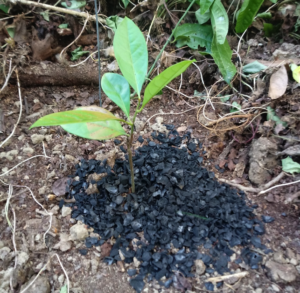 Plant TLC: Adding Soil-Enriching Biochar to Help Seedlings Survival
Plant TLC: Adding Soil-Enriching Biochar to Help Seedlings Survival
To increase the chance of the seedlings’ survival once transplanted to the affected areas – since much of the soil was dry and damaged – we added biochar when planting them.
Biochar is a soil-enhancing charcoal made from sustainable sources that helps retain water and nutrients in the soil for plants to take up as they grow. Biochar has also been known to clean mercury contamination from the soil, which would also improve the soils previously contaminated activities.
A total of two tons of biochar were acquired from the nonprofit consortium CINCIA (Centro de Innovación Científica Amazónica), half of which were kindly donated.
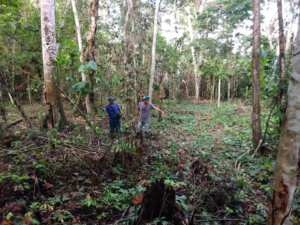 Preparing the Restoration area
Preparing the Restoration area
Preparation of the restoration area was originally planned for March and April of this year, but the delay of the rainy season last year allowed us to get a head-start in prepping the area for the seedlings in mid-September 2019 (which was great timing, as our original timeline would have been affected by the COVID-19 global pandemic).
Our agroforestry experts prepared the land through clearing weeds and shrubs from the area. The standing Guayaba trees (Psidium guajava) already present in the forest were left, serving as a complementary tree species to the rosewood seedlings, providing shade and protecting them from intense sun and rain.
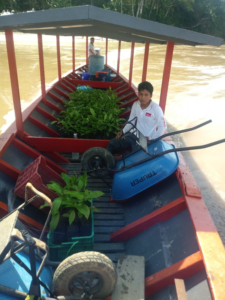 Giving the seedlings a new home
Giving the seedlings a new home
From October-December 2019, our agroforestry technicians planted the rosewood 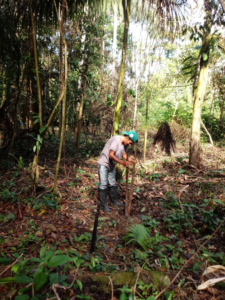 seedlings mixed with biochar. The first 1,250 seedlings were transplanted to a target area of 2.1 hectares (5.2 acres), which had been verified as an ideal area for restoration through reforestation using this species. A tractor and a short boat trip down the river helped bring the seedlings to their new home, where they were planted throughout the end of 2019.
seedlings mixed with biochar. The first 1,250 seedlings were transplanted to a target area of 2.1 hectares (5.2 acres), which had been verified as an ideal area for restoration through reforestation using this species. A tractor and a short boat trip down the river helped bring the seedlings to their new home, where they were planted throughout the end of 2019.
The remaining 1,250 unplanted rosewood seedlings continued to grow in the nursery through the rainy season, along with other local seedlings to support a healthy forest ecosystem and the steady growth of rosewood, including 500 moriche palms (Mauritia flexuosa or “aguajes” in Spanish), 150 bolaina blancas (Guazuma crinita) and 650 Amazon grapes (Pourouma cecropiifolia) seedlings. By April 2020 the rainy season had ended, and our team had just finished planting the remaining trees. As of April, a total of 5,000 trees have been planted: 2,500 rosewood seedlings and 2,500 complementary tree species. We look forward to studying how this reforestation effort improves degraded forest, and based on the survival rate of the seedlings, whether it can be expanded to other areas of the Amazon disturbed by slash-and-burn agriculture and illegal gold mining.
We thank the National Fish and Wildlife Foundation for their generous contribution to carry out this important project, which will support the planting of almost 5,000 essential trees to restore damaged lands in the Amazon.
——

